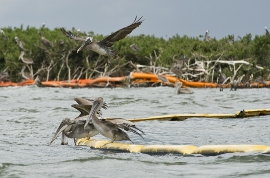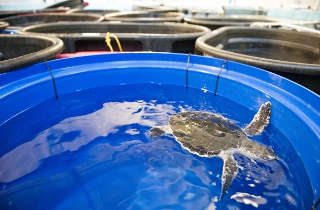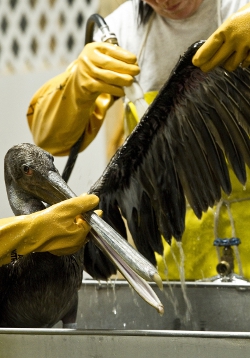Crude Awakening
By Julie Flaherty
What veterinarians are learning about rescuing wildlife trapped in our oily messes

Pelicans roost on the boom laid to protect fragile marshland in Louisiana’s Barataria Bay. Photo: by Alonso Nichols
On a sunny morning in mid-August, about 50 miles from the source of the Deepwater Horizon oil spill, a fishing boat commandeered for wildlife rescue edged up to a small island in Louisiana’s shallow Barataria Bay. Although the well had stopped spewing weeks earlier, the boat’s motor still churned up oil, which appeared as gray wisps on the surface.
“The boom has washed up on shore there,” said Tom MacKenzie, a guide with the U.S. Fish and Wildlife Service, pointing to the spongy, oil-absorbing tube that hung on the island’s low mangrove trees like a dirty garland. But the most recent orders were not to step on the island, either to reposition the boom or to look for oil-contaminated wildlife, and it was easy to see why. “They are still nesting,” MacKenzie said of the hundreds of brown pelicans that blanketed the island, many of them tending eggs or young hidden in the vegetation. Tramping in there could do more harm than good.
None of them was covered in gunk, like the birds they rescued in early June, but MacKenzie was still worried. They had recently been pulling in lightly oiled birds that had probably been that way for weeks.
Even a little oil on the belly can thwart a pelican’s waterproofing, deterring it from going into the water, and therefore from hunting and eating. Dehydration and starvation set in, and with the compulsion to preen, the bird swallows the oil, traumatizing its intestines, liver, kidneys and nervous system.
Florina Tseng had warned about this. “Usually it’s the more heavily oiled birds that are found first and get into rehab,” said Tseng, director of the Wildlife Clinic at the Cummings School of Veterinary Medicine at Tufts, who was preparing to spend a week in Louisiana treating oiled wildlife. The lightly oiled birds still suffer, “but they are harder to catch, so by the time they come in, sometimes they are in worse shape,” she said.

A Kemp’s ridley turtle recuperates in one of the tanks at the Audubon Nature Institute outside of New Orleans.
Tseng, an unflappable presence in any veterinary emergency, is an oiled wildlife expert, and it went without saying that she would join the waves of veterinarians and wildlife biologists who converged on the Gulf area after the drilling rig explosion in April. She has studied the myriad ways, fast and slow, that crude, diesel, jet fuel and gasoline can injure wildlife.
There have been plenty of opportunities. Animals are so frequently caught up in these wholly unnatural disasters that a veterinary specialty has emerged to deal with it. It is far more than just setting up sinks and hoses. With each spill, these professionals learn a little more about the best way to treat animals trapped in our gooey messes.
“The ethical argument is we all use petroleum products, and so we’re all responsible for this spill, too,” Tseng said. “We owe it to these birds to care for them and, hopefully, give them a second chance.”
More Spills Than Ever
When Christine Fiorello, V95, first told friends she was taking a job as a veterinarian with the Oiled Wildlife Care Network, a California group that organizes spill response, they were surprised. “They said, ‘Are there really that many oil spills in the world that there need to be vets who do only that?’ ” she said. “Sadly, there are.”
Oil gets into the environment with disturbing regularity, through broken pipelines, tankers that run aground, drilling platforms that leak, accidents that happen during transfer of oil between tankers and ships that illegally dump their oily bilge water. There are also the natural seeps from the ocean floor, “mystery spills” where the source is never identified and the downright bizarre, such as a cargo container holding six thousand gallons of olive oil that started leaking into a storm drain in the city of San Leandro, on San Francisco Bay. Not every spill threatens wildlife. In 2007, some 8,000 spills were reported in California, and the Oiled Wildlife Care Network responded to seven (including the olive oil).
“Certainly several times a year there is something going on,” Fiorello said, noting a recent pipeline break in Utah that sent 500 barrels of oil into a Salt Lake City creek and another that poured a million gallons into a Lake Michigan tributary. Even the small spills are an opportunity for improving procedures that can save animal lives in a catastrophe like the BP spill in the Gulf. And between disasters, Fiorello and her colleagues train volunteers who must learn the protocol before a spill happens.
In Louisiana, the bird rehabilitation ended up at a converted lumberyard in Hammond, a city not far from the Gulf of Mexico, but far enough not to be disrupted by the hurricane season. Stalls for stacking two-by-fours became sick bays for triaging birds in various states of unwash. Twenty-five-foot plywood pens were built to house more than 300 pelicans, terns, spoonbills, gulls, gannets and rails.
Years ago, oiled birds would have been rushed into a sink on arrival at a rehab center like this. But veterinarians discovered that birds survive better when they are monitored for a few days first. It’s a matter of treating them for dehydration, hypothermia and anemia before they undergo the stress of washing, Fiorello said. Although the team at the Hammond center supplied every comfort, from live minnows in pools of running water for the pelicans to tree branches for the shy egrets and herons, the veterinarians were under no illusion that the birds enjoyed their time there.
“It’s terrifying,” said Fiorello. “It’s like being surrounded by giant, scary, primate predators,” many of them wearing goggles or Tyvek suits or rubber gloves duct-taped to their sleeves to protect themselves from the oil.
While it’s no day at the spa, the care is state of the art. In previous spills, rescued birds died by the hundreds from a respiratory infection called aspergillosis. It’s still a problem, but less so now that the veterinarians give each bird a prophylactic dose of antifungal medication and carefully monitor the ventilation in the cages.

Volunteers rinse a pelican at the Hammond Wildlife Rehabilitation Center. Photo: by Alonso Nichols
Loons, sea ducks and other marine animals that spend most of their lives in the air or floating on the water are housed in net-bottomed cages to prevent the sores that develop from sitting on solid ground. Some birds get special U-shaped pillows to rest on.
Even the washing protocol has been carefully studied. Rinsing, for example, can be trickier than soaping. To get the detergent out, the water can’t be too hard or too soft; the temperature should be 104 to 105 degrees, and the Spa 2000 is the showerhead of choice for getting the pressure just so.
“If you’re doing it right, he’ll be completely soaked and then the feathers will start looking dry and water will start beading off,” Tseng said. That’s the signal that one of the miracles of nature, the interlocking barbs that make up the feathers, have regained their structure, forming the waterproof matrix that makes the bird an air-tight vessel, keeping it from freezing at night, broiling in the hot sun or sinking in the water. “And that’s very gratifying,” she said, “but it’s hard to do it well.”
Judgment Call
Tseng has spent much of her career improving the care of oiled birds. Before joining the Cummings School as an assistant professor in 2000, she was the staff veterinarian for the International Bird Rescue Research Center (IBRRC), a nonprofit that assists in spills around the world. She was there for the aftermath of the Cordigliera spill off the coast of South Africa, when 1,200 rare African black-footed penguins were taken in for treatment.
For Fiorello, who has a doctorate in conservation biology and disease ecology and spent the last three years as an assistant professor at the University of Georgia, the BP leak was a crash course in hands-on post-spill treatment. She accepted the Oiled Wildlife Care Network job before the well blew, hardly expecting that her first task would be working on the largest oil spill in U.S. history.
Even before her official start date, she volunteered to help treat the heavily oiled birds being pulled out of Louisiana, Alabama and Mississippi waters. As many as 40 birds would come in to the rehab center at once, and it was her job to care for the weakest of them and decide when they were stable enough to be washed. The veterans told her to scrutinize the blood work, but trust her gut.
“There’s always a judgment call, how much to rely on the objective numbers versus the overall feeling of the bird,” said Fiorello.
She quickly saw that the birds are more than just their lab workups. Pelicans, which stay close to shore and often observe humans from their perches on piers, are relatively laid back. “They can handle it,” she said of the washing protocol.
Gannets, on the other hand, spend most of their lives at sea, soaring a hundred feet above the ocean and then diving in at 60 miles per hour to catch fish. “They are beautiful birds,” Fiorello said, “but boy, do they have an attitude. They are just not afraid. You open the cage, and they give you this look that says, ‘Bring it on.’ ” They have very strong, sharp bills, and they are happy to use them. But from a rehabilitator’s perspective, they are also harder to keep healthy in captivity.
That fragility was even more apparent when the IBRRC began in 1971, in response to the collision of two tankers in San Francisco Bay that spilled a million gallons of oil. Of the 7,000 birds washed in that spill, not quite five percent survived to be released.
But wildlife veterinarians have learned a lot since then. Today, everyone knows that Dawn dishwashing liquid is de rigueur for bird cleaning, but it wasn’t until laboratory tests with feathers in the 1980s that researchers settled on it as the most effective way to clean a bird and still have it survive the bath. In the 1950s and ’60s, desperate do-gooders slathered birds with things like butter, lard, powdered chalk, mascara remover and waterless hand cleaner. While ineffective, these applications were probably less harmful than the harsh, fuming solvents that were used in the 1970s.
Not every new development is a good one. “In any spill, there are people coming out of the woodwork who have crazy inventions,” Tseng said. She was unimpressed by an appliance that emerged from Europe a few years ago. “It was kind of a washing machine. You would put the bird inside, and the wings were pinioned and the legs were shackled.” Tseng took a pass on that one.
The Oiled Wildlife Care Network is currently experimenting with powdered diets for seabirds (easier to store and transport than freezers full of fish) and infrared cameras to quickly check whether a bird’s feathers are waterproof. Tseng would like to see better antifungal medications to treat the respiratory problem and blood test criteria that would tell a veterinarian whether the bird has a decent chance of survival. “Just being able to more closely triage birds would be helpful in allocating resources,” she said.
Worth the Effort
Whenever a big spill dominates the news, someone raises the question of whether the wildlife washing is worth it. A Newsweek article with the headline “Should We Clean Oiled Animals?” quoted Daniel Anderson, an ornithologist at the University of California, Davis, as saying, “It might make us feel better to clean them up and send them back out. . . . But there’s a real question of how much it actually does for the birds, aside from prolong their suffering.”
The article cited Anderson’s disappointing study of pelicans that were rescued from the American Trader spill of 400,000 gallons of crude off Huntington Beach, Calif., in 1990. It found that only 12 to 15 percent of the rehabbed birds survived for two years, compared with 80 to 90 percent of uncontaminated pelicans. He argued it would be better to euthanize some species and put the time and money saved toward other conservation efforts.
“It’s very frustrating to hear this brought up again and again,” Tseng said. She can just as easily point to a study of western gulls in California that found better survival rates among the birds that had been oiled and rehabilitated than among the control birds.
But generally, she said, there is a dearth of good studies on what happens to the birds post-rescue. It just isn’t that easy to track seabirds. Radio transmitters, which were used in the 1990 pelican study, may themselves interfere with the birds’ survival, said Jay Holcomb, executive director of the IBRRC and the manager of the Hammond rehabilitation facility.
He brought up a study of common murres (relatives of the puffin) that were fitted with transmitters and then observed both in captivity and in the wild. “They would spend all their time fighting to get the transmitter off,” he said. “They would rip them out of their back, leaving a hole. And in the wild, they wouldn’t eat.”
Leg bands are less intrusive, but also less reliable. “The only way you get banding data is if one of these birds washes up dead on the beach,” Tseng said. “Most of the time, if they die, they sink.”
It’s always worthwhile to save even a few birds of an endangered species, according to Tseng (she’s not the first to point out that brown pelicans were only recently delisted). But even treating more common species is valuable practice.
She particularly bristles, in her own calm way, at the implication that she and the other rescuers toil at a futile task to make themselves and the public feel better. “I’ve worked at spills where we euthanize half of the birds in the beginning if they don’t have a decent chance of going through the whole process,” she said. “It isn’t as if everyone is a bleeding heart and wants to save every bird. Everyone is very realistic during these spills.”
Thankfully, that kind of culling hasn’t been necessary with the Deepwater Horizon spill. As of mid-September, only 8,000 or so birds had been collected, alive or dead, and only about half of those were visibly oiled. It could be that many more died and sank. But just as likely, the birds benefited from the warm Gulf waters, which kept more of them from freezing to death before being found. (In contrast, the cold proved devastating to the 250,000 birds believed to have died in the Exxon Valdez spill in Alaska.) The warm temperatures also seemed to help evaporate the oil—its disappearance hastened by oil-eating bacteria. With much of the surface oil gone, the rehabilitators in Hammond planned to return many of the birds to unsullied areas nearby.
But even if the rescue efforts had had a less happy outcome, Tseng would still have argued that they were worth it. There is a practical argument to consider: if wildlife professionals hadn’t done it, people with less skill would have tried, potentially hurting themselves (crude oil contains carcinogens and neurotoxins) and hurting the birds, too. “No one is going to stand by,” Tseng said, “and see these oiled birds and not do anything about it.”
See also “First-time Mission,” about the effort to save sea turtles.
This story first appeared in the Winter 2010 Tufts Veterinary Medicine magazine.
Julie Flaherty can be reached at julie.flaherty@tufts.edu.
